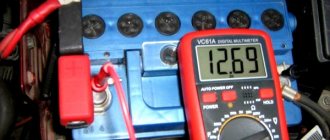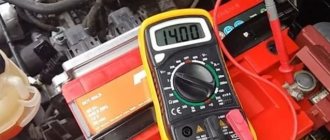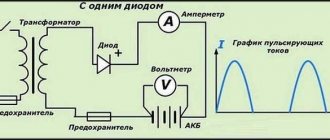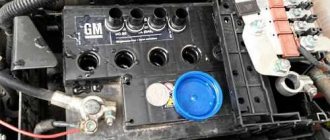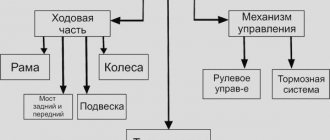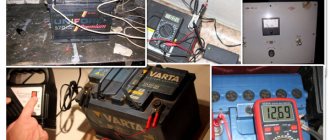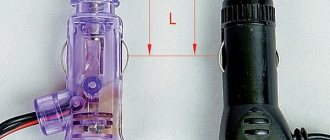At subzero temperatures in winter, old batteries with cells damaged by age begin to lose charge faster due to a sharp increase in internal resistance. The driver comes in the morning, inserts the key into the ignition, and the starter is almost unable to crank the engine due to lack of electricity. Flashing the headlights and other resuscitation measures help to gather strength and start the power unit. However, you cannot turn it off and you need to accumulate enough energy during the trip to replenish the battery, and best of all, fully charge the battery so as not to experience difficulties the next day. How to do this correctly?
What happens if you mix up the battery terminals? More details
The battery does not charge when the engine is idling
This is a misconception that dates back roughly to the time of the first widespread personal cars in the Soviet Union. At that time, this thesis really corresponded to reality - the generator there produced quite a small current at idle speed. The experiment is clear - start some kind of “penny”, turn on the low beam, rev, compare the brightness of the light at idle and at high speeds.
But that was forty years ago! Nowadays, car manufacturers at least take into account the fact that cars have to sit in traffic jams a lot, that is, work at those same idle speeds.
Is it possible to restore a battery during a deep discharge and how to do it?
- 1 Why you shouldn’t let your battery reach a deep discharge state
- 2 Is resuscitation possible?
- 3 Which batteries are not afraid of deep discharge
- 4 Recovery methods 4.1 Mechanical cleaning
- 4.2 Chemical method
- 4.3 KTC
- 4.4 Distilled water
- 4.5 Polarity reversal
- 4.6 Desulfators
Motorists quite often encounter situations when the battery is severely discharged and its charge is no longer enough to start the engine.
Usually in such situations there is only one way out. This means removing the battery, putting it on charge, and then returning to the usual operating mode.
But it also happens that when the battery is discharged, it is no longer possible to restore it. The battery does not react in any way when connected to a charger, and when started from a ROM or booster, the generator does not provide charging.
Here you need to know what deep discharge is, why it is dangerous, and how to resuscitate the battery.
How to check your car battery charge
The easiest way to check the battery charge level is to use the charge level indicator built into the battery case.
Charge level indicator
At a normal level, its color is in most cases green, at an insufficient level it is dark, and at a completely discharged level it is transparent (colors may vary depending on the battery model).
The principle of operation of the indicator is based on measuring the density of the electrolyte located in the battery banks.
So, for a fully charged battery, the density of the electrolyte must be no less than 1.27 in the summer and 1.29 in the winter (subject to the use of a special winter electrolyte or batteries adapted for use in low temperature conditions).
If the battery requires charging (black indicator), the electrolyte density will be in the range from 1.24 to 1.16. At a lower density (less than 1.16), the indicator will become transparent.
By the way, this technique can be very successfully used to control the charge of serviced batteries.
For this
you need to use a hydrometer, available in virtually every car store. They are also comfortable monitoring the level and quality of the electrolyte.
Voltmeter or load plug
You can also check the battery charge level using
load fork. The device is
Built-in ammeter and load resistor.
The battery testing process is carried out in two stages.
Main factors affecting battery performance
Discharge of the device may occur due to improper use. Sometimes this is affected by unstable battery power: it is either discharged too much or is kept connected to the charger for too long.
The reason for battery discharge is most often incorrect operation of the product.
If the battery is severely discharged and left in this state for a long time, then the process of sulfation begins when spongy lead turns into lead salts. This process resembles cirrhosis of the liver, where living active cells turn into connective tissue.
On the other hand, you cannot often use “fast charging”, which is not recommended by manufacturers and can only be used in the rarest cases. Otherwise, the active mass of the battery will crumble.
Another common cause of deep battery discharge is the negligence of the car driver. Motorists often forget to turn off their headlights, fog lights, and ignition. In this condition, the car can sit in the garage for several days. It is important to note that if the car has been parked for too long and the charge has dropped to 2 volts, it will most likely not be possible to bring the battery back to life.
So, does it charge without stopping?
Now many may think that the battery is charged without stopping, that is, while the engine is running, current is being generated. Not quite so - the battery takes exactly as much charge as it spent (say, on starting) and then turns off. If you always charge the battery, it will simply boil and may explode , this is even dangerous, therefore, in the generator-battery circuit, there is a special relay-regulator that sees the “fullness” of the battery and turns off the current supply at the right moment (by the way, it may break, but you can really check it with your own hands ).
Read also: Comparison of LG and Samsung washing machines
What to do if the battery is completely discharged
Many automakers claim that one full charge will have a worse effect on battery performance than several full discharges. Of course, you don’t need to constantly bring the battery to this state, but you shouldn’t despair if it’s completely dead either.
When charging the battery, it is important to observe the polarity
It is possible that after a deep discharge the battery will lose part of its capacity, but its performance will still remain. For deep discharge, you will need a professional level charger or a sufficiently qualified specialist. Therefore, the safest solution to the problem would be to contact a car service center, where professionals will resuscitate the battery.
If the battery goes out while driving away from home, you can try to light it from the battery of another car. However, before this you need to pay attention to the contacts and ensure a quality connection. If there is a whitish coating on the terminals, it must be removed.
Next, the charge will occur from the generator. However, it is better to try to restore the battery at home, using modern chargers that do not require outside intervention and control the process themselves.
Battery chargers
There are many different devices for charging batteries on the modern market: from the simplest and inexpensive to the expensive and multifunctional. A natural question arises: what to choose? Because cheap is not always good.
It is possible to agree with this statement, if we take into account that when choosing a charger model it will be possible
operate only with high-quality devices.
Simple
Let’s say you need a simple charger that allows you to keep the battery charge within normal limits, charge it if necessary, and at the same time
not requiring control.
A good choice would be, for example, Smart Power - a simple charger that, however, performs its own functions completely.
On the plus side, it is possible to indicate the presence of three operating modes, which provide a combined charge - starting from charging with maximum current and ending with charging by voltage.
When the maximum voltage is reached at the battery terminals, the charger automatically turns off.
An additional advantage is the ability to turn on the charger when the voltage drops at the terminals, due, for example, to prolonged downtime, which allows the use of the charger during winter storage of the battery.
The downside is that it is unknown what value the manufacturer has set as the “cut-off” voltage – most likely a low voltage, which ensures the greatest safety. So
, a large charge will most likely be no more than 75-85% of a large one.
With the ability to manually voltage the charge force and adjust the current
An example of a device would be “Vympel-40”.
In addition to the fact that the device has manual settings, it can also work in automatic mode, like the one discussed above.
What are the advantages of using it?
An involuntary charge of the battery with a voltage of 15 V brings the battery charge to 85-90% of the capacity - by switching to manual mode, the user can, if necessary, ensure a 100% charge of the battery as discussed above.
The ability to manually select voltage and current allows you to charge a completely discharged battery, because in the latter case an increased initial charging current is required, which automatic devices in most cases cannot provide.
What is the alternative?
Not everyone has advanced chargers. However, people now have a lot of different gadgets and some purchase universal chargers that allow them to charge different types of batteries. Including lead-acid. A restorative charge can be made with their help. It is quite possible that there is a special mode for this, but ample settings allow you to select it manually. At least, it is possible to set a small current of 0.03*C─0.1*C and trigger when a certain voltage is reached in them.
[Show slideshow]
One of the most popular universal chargers is the iMax B6 and its modifications. Something similar is produced under the brands Pulsar, Robiton, etc. Just select the mode for lead batteries, set the current, the number of cells in the battery and start charging. If necessary, these devices can be used to deliver a shock.
How does a generator work?
Some novice drivers think that the battery begins to charge only when the car starts and drives, that is, energy is accumulated due to the movement of the wheels. But this is fundamentally wrong! Think for yourself, if such a structure existed, the charge would not be enough even for a couple of days, because in megacities there are often traffic jams - on a cold day you need to warm up the engine for a long time so that the oil becomes liquid, the result is a huge energy output, but there is no replenishment! At such costs, your battery would die from deep discharges within a month.
Therefore, energy generation follows a different principle.
You and I all know that when the engine starts, the most important shaft in the engine begins to rotate - the crankshaft, it transfers its energy (torque) to the wheels - if I can put it roughly, it is this that pushes the car. But it turns not only the wheels; often several belt drives are attached to it.
It is this belt drive, or simply a belt, that is connected to the generator shaft, that is, if the crankshaft rotates, then the generator shaft also rotates. In turn, magnets are attached to the shaft, which move next to the copper windings - an electric field (current) arises - which is transferred to the battery, that is, charging occurs.
In simple words, immediately after starting, the generator begins to charge the battery. Even if the car is standing still and not moving anywhere. Mechanical energy from engine operation is converted into electrical energy.
The generator does not charge: reasons
Let us note once again that a normally operating generator completely replenishes the battery charge level, while the charge decreases under load. At the same time, in the general circuit there are many elements that can cause a battery charge failure. Often, problems arise both in the mechanical part (generator drive, bearings, etc.) and in the electrical part (break or short circuit of windings, burnout of the diode bridge, wear of brushes, breakdowns). The generator relay regulator should also be checked separately.
One way or another, it is important to find the problematic element. Note that usually the vast majority of generator breakdowns or battery charging problems can be eliminated (by replacing the drive belt, rollers, repairing the generator, inspecting contacts, terminals and other elements). However, there are breakdowns that become the basis for replacing the entire generator assembly.
We also recommend reading the article on how to increase the density of the electrolyte in the battery. From this article you will learn what the density of the electrolyte affects, how to measure the density of the battery, and also how to change the density of the electrolyte in the battery.
The terminals must fit tightly; oxidation is not allowed. The same goes for electrical wiring. All wires must be intact, and the contacts must be securely fastened and clean. By the way, it is important to periodically clean the contacts from oxidation, since the current will pass through the oxidized outputs worse.
You should not yet rule out mistakes that may be made during generator maintenance. Incorrect contact connections can cause generator malfunctions, battery discharge and other malfunctions.
Battery charging frequency
If all operating rules are followed, the battery should be recharged at least twice a year. It is better if it happens before winter and after winter.
They also charge if the car has been parked for some reason for a long time, because the battery has a self-discharge property, and the car also has an alarm system that constantly consumes electricity.
Manufacturers of rechargeable acid batteries include leaflets or instructions with their products; if you carefully read and follow their instructions, the batteries will serve their owners for a long time and reliably.
Idling in winter
What happens during the winter period? YES, it’s practically the same thing, the main thing is to start the engine, then the generator will do everything (if it’s working properly, of course).
But winter also has its own conditions - the whole point is that a cold battery (for example, at an ambient temperature of -20) takes a charge very poorly! Only after the engine has warmed up and the temperature under the hood begins to rise does charging occur more intensely.
Therefore, if your trips, especially in winter, are short (in extremely negative temperatures), it is advisable to check the battery charge at least once every couple of weeks; the battery simply may not have time to recharge. It threatens that at one fine moment (in the morning) you will not start the engine.
To be fair, it is worth noting that if there are no low temperatures, let’s say it stays at “-5”, “-10” degrees. Then the charge will occur normally, there is nothing to worry about.
Now let's watch a short video.
I'll end here, I think it was useful.
Similar news
- Which terminal to remove from the battery. For long-term parking, for…
- Do I need to unscrew the battery caps when charging? And how is that …
- How to buy a battery for a car? And don't make mistakes
Add a comment Cancel reply
How long does it take to “drive” a battery with a capacity of 60 Ah without harm and to charge it to 100%.
Today we'll talk about batteries. More precisely, how long and how exactly to properly charge the battery yourself, so as not to harm the battery. Let's start by defining the most common type of battery.
A battery with a capacity of 60 A/h is the most common type. This battery is equipped in modern passenger cars not only of domestic production, but also foreign units, so to speak, budget foreign cars. So we will talk about these batteries.
The main question for many car owners is the time it takes to charge the battery. After all, many people know that you shouldn’t be overzealous. After all, running the battery idle is quite harmful. A charged battery simply boils away if it is not disconnected from the charger in time.
Why is this question so relevant? Because none of the instruction manuals contain exact instructions regarding the time
charge. Not a single company involved in the production of batteries gives advice or exact time frames. Even the most popular manufacturers are not guilty of such precision. However, you can still take away something useful for yourself from the instructions.
How to understand that the battery has gone to zero
Many drivers are interested in the question of how to determine that the battery is completely “depleted”. When the device is operational, it is capable of receiving and delivering currents for which it is designed according to its characteristics. The strength of the starting current corresponds to the capabilities of the starter. In addition, the battery must retain its charge for a long time. If any of the functions are not performed, then the battery cannot be called serviceable.
The main signs of a “dead” car battery can be something like this:
- it is not possible to start the engine in the morning, but the car has recently been driven;
- the device gets very hot or takes a long time to cool down after charging;
- the battery does not charge at all or loses its capacity very quickly;
- change in electrolyte color (for serviced products);
- the appearance of an unpleasant odor, possibly burning.
Everything you need to know about battery charging
Protecting the battery from discharge implies regular diagnostics of the device’s performance, as well as its correct charging. If the battery is maintenance free, the voltage level for such a device should be 14.4 volts. To prevent hydrolysis of water in the electrolyte, the voltage should not be allowed to exceed 15.5 volts.
To charge, you need to connect the unplugged charger to the battery. First, the minimum voltage level is set on the charger, and when it is connected to the network, this parameter must be increased to 14.4 volts. The current setting should drop to 0.2 amperes - if this happens, the battery will be fully charged.
As for charging time, it depends on the condition of the battery. If the battery is partially discharged, then when the current parameter is set to 20% of the total capacity, the battery needs to be charged for about one hour. At a current strength of about 10%, it can take up to 16 hours to charge the device.
Sorry, there are no surveys available at this time.
How long to charge a dead car battery?
The battery charge is constantly being wasted, even when you are not using the car. First of all, it is spent on starting the engine, on a constantly working alarm and locks in the car, on a generator, and a starter. Replenishes its charge using a generator. Your battery does not always receive the charge it needs while the generator is running. And after the trip, in order to start the engine, you may not have the required amount of charge. How can you find out how long it will take to charge a dead battery?
Charging the battery takes 10 – 20 hours. You need to charge 1/10 of the current from the battery capacity.
To quickly charge a dead battery, you can use a mode with a current of 8 A for 3 hours and another hour with a current of 6 A.
In conclusion, I will say, try to avoid a complete discharge, because this is harmful and reduces the battery capacity.

